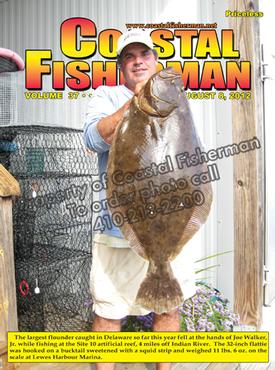


Article by Pat Schrawder
 WHEN THINGS GO WRONG
WHEN THINGS GO WRONG
I had originally intended to write about another subject matter this week but, as often happens, something takes place that deserves more attention like last week after the US Coast Guard had to rescue two vessels that were sinking offshore of Ocean City. One vessel, a 27-foot open boat, was successfully brought back to shore along with its passengers, but the other, a 38-foot vessel with 9 passengers on board sank. Fortunately, the nine people on board were brought safely back to Ocean City and transported to a medical facility for treatment. In both cases, the survival of the passengers was due to the assistance of private vessels in the area and to the good work of the US Coast Guard.
It was also possible because the two vessels were able to successfully contact the US Coast Guard by VHF radio and because private vessels in the area heard those distress calls. All this brings up the matter of safety and the electronic options that are available to you that can make a critical difference when things go wrong.
VHF: As the above situations prove, a VHF radio is your most valuable and basic safety item of electronics. You need to be able, if possible, to call in a distress situation. Unless your VHF is pretty old, it will be equipped with DSC. There will be a button on your radio that is marked “emergency” or “distress”. As the system is designed to work, when that button is pushed, an automatic distress signal is sent out that can be picked up by the Coast Guard and/or other vessels giving your location and the name of your vessel. You can also indicate the type of distress. For it to work properly, you must apply for a free MMSI number and program it into your VHF, and then have your GPS interfaced with your VHF radio. Of course, use of this unit is dependent upon your having 12 volts available to power the radio. If your vessel is sinking, water may have risen to the point that your batteries are rendered useless and so are your electronics.
EPIRB/PLB: An Emergency Position Indicating Radio Beacon or Personal Locator Beacon is a device that is battery operated and transmits a unique identifier number directly to satellites that forward the signal to Coast Guard Search and Rescue. The unit usually also contains a strobe to make location easier. The unit is designed to be registered with the US Coast Guard in advance giving them the serial number, name of vessel, contact person, etc. Some units also have a built-in GPS. With this information, the Coast Guard should be able to locate your vessel within a short period of time. Please remember that the search and rescue personnel will be homing in on the EPIRB or PLB. If you are separated from the vessel, make sure the EPIRB/PLB is with you. PLB’s, in fact, are designed to be worn on the individual. They are less expensive (around $300) making them an increasingly popular item.
LIFE RAFT: If you have to abandon your vessel in an emergency, it sure is nice to have some place to go other than into the water. This is where the life raft comes into play. They come in various sizes, configurations and prices from basic floating platforms to deluxe models that have covers and are packed with supplies and an EPIRB. Their size and cost make them difficult for some smaller vessels but, if you can accommodate one, it will be greatly appreciated if the time comes that it has to be used.
S.A.R.T.: Search And Rescue Transponders are devices that are normally only found on larger vessels mostly due to their cost ($1,000 and above) and to the fact that boaters have never heard of them. They are required for commercial vessels and those carrying more than one life raft. Simply put, they are a device that is designed to be placed on a life raft or mounted on the vessel, and once turned on, can be activated by the beam of a another vessel’s X-band radar unit. Once activated, it sends a return signal to the activating radar which results in a series of dotted lines showing up on that radar screen indicating the location of the S.A.R.T. Even though the average boat may not have one of these units on board, anyone who has X-band radar on board needs to be familiar with this device. The reason being that, if you are on your boat with radar and you suddenly notice a series of dotted lines show up on your screen, you know that there is a nearby distress situation. You should call the Coast Guard on Channel 16 to report your sighting.
Any time you go out on the water, the unexpected may happen and you need to be prepared as much as possible. Any one or more of these safety devices will help make your rescue successful.
Pat and her husband, Larry are owners of L&L Marine Electronics on Golf Course Road in West Ocean City, MD.